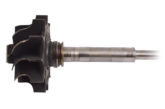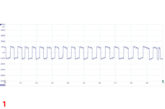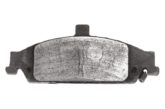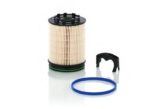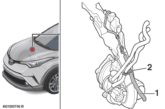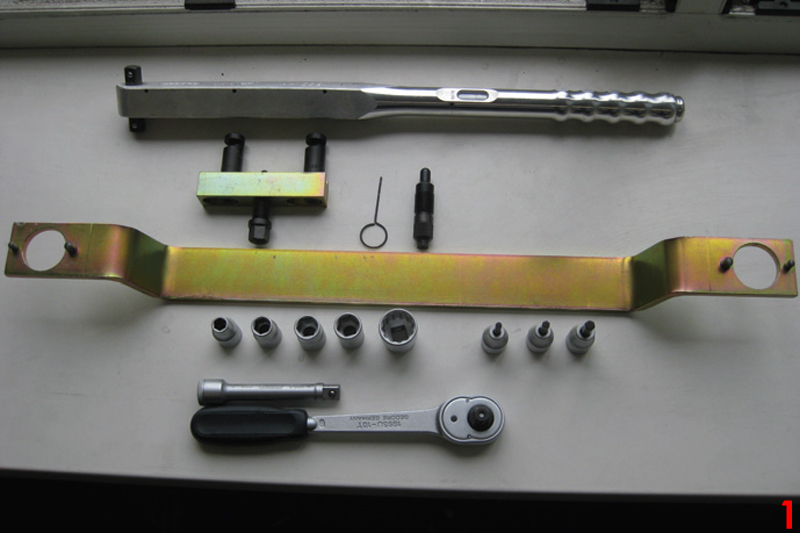
In this month’s Belt Focus, the technical team at Continental details a step-by-step guide to replacing a timing belt on a 2.8L 30V engine found in the Audi A4, A6, A8 and VW Passat, and highlights the mistakes to avoid.
The 2.8L 30V engine is installed in Audi and Volkswagen car models in large numbers. When changing the timing belt, critical errors are often made, for example in handling the tension pulley. When the timing belt is changed, the tension pulley, the tensioner, the idler pulley, the water pump and the thermostat should also be replaced at the same time. Audi and VW recommend performing a change every 120,000km.
Technicians require the following special tools for belt changing (Fig 1/main image):
- Camshaft sprocket remover no. 3032
- Crankshaft locking tool no. 3242 – for example, from the Conti® Tool Box
- Camshaft locking tool no. 3391
- Supporting sleeves no. 3369
The working time for the Audi A4 is 2.9 hours, for the A6 (models up to 1997) 2.5 hours, for the A6 (1997 and later) 3.5 hours, 1.9 hours for the Audi A8 and 3.3 hours for the Passat.
Preparatory work
To start the process, first identify the vehicle using the engine code and disconnect the vehicle battery. Here it is important to keep in mind that when the timing belt has been removed, the crankshaft and the camshaft must not be turned.
Remove spark plugs so that the engine can turn more easily. Turn the engine in its normal direction (clockwise). The engine must only be turned at the crankshaft sprocket and not at other sprockets! Observe all tightening torques.
Removal
Begin by jacking up the vehicle at the front and support it. For the Audi A4 and A6 (1997 and later models), the cooler support plate must also be put into the service position:
- Remove the front bumper
- Remove the air intake hose between the front panel and the air filter
- Remove the screws in the front panel
- Attach the support sleeves no. 3369 in the front panel
- Push the front panel forwards
- Insert the top back screws into the front holes to hold the panel
Next, is the removal. Remove the viscous fan (left-handed thread), timing belt ancillary units, and the left and right timing belt cover.
Turn the crankshaft right to TDC (OT) in the third cylinder. The control marks have to match up (Fig 2).
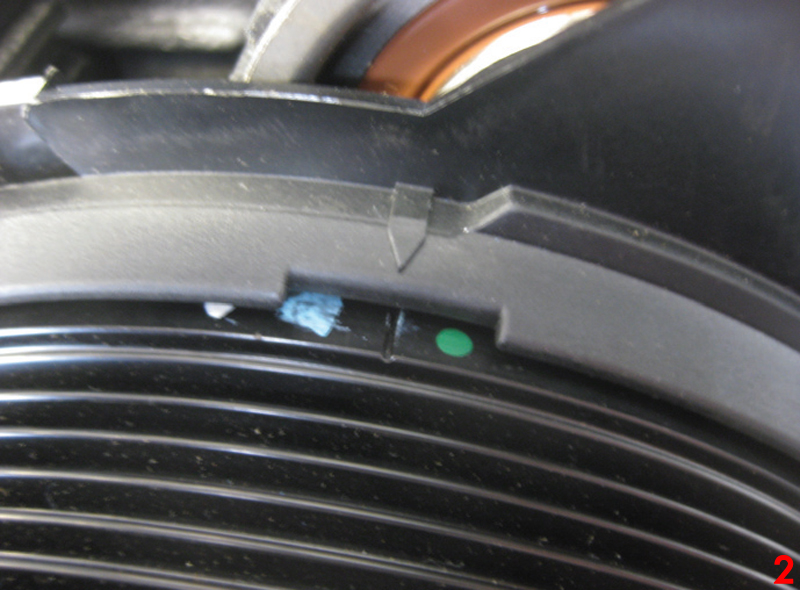
You must also ensure that the large holes on the mounting plates for the camshaft sprockets must be opposite each other (Fig 3). If this is not the case, turn the crankshaft to the right a further complete turn.
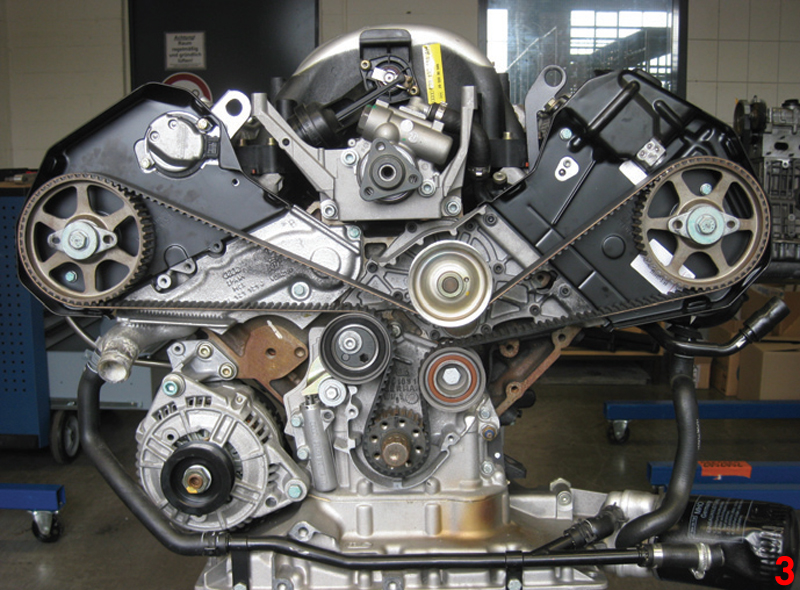
Now, remove the plug from the crankcase and screw in the crankshaft locking tool (no.3242) (Fig 4). Please note that the TDC (OT) hole in the crank web must be in line with the hole for the plug.
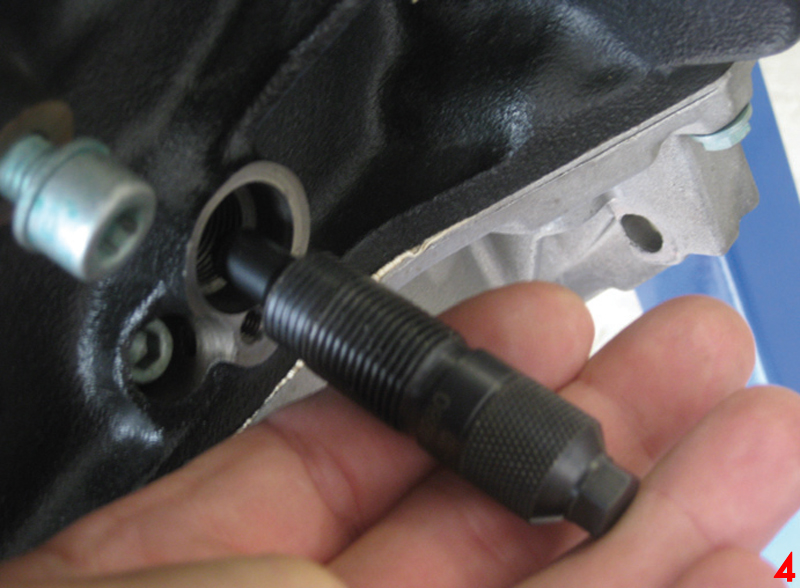
Once that is done, use an 8mm hex key to turn the tension pulley to the right until the holes in the clamping rod line up with those in the tensioner casing. Hold the clamping rod by inserting a locking pin with a diameter of 2mm through the hole in the tensioner casing (Fig 5).
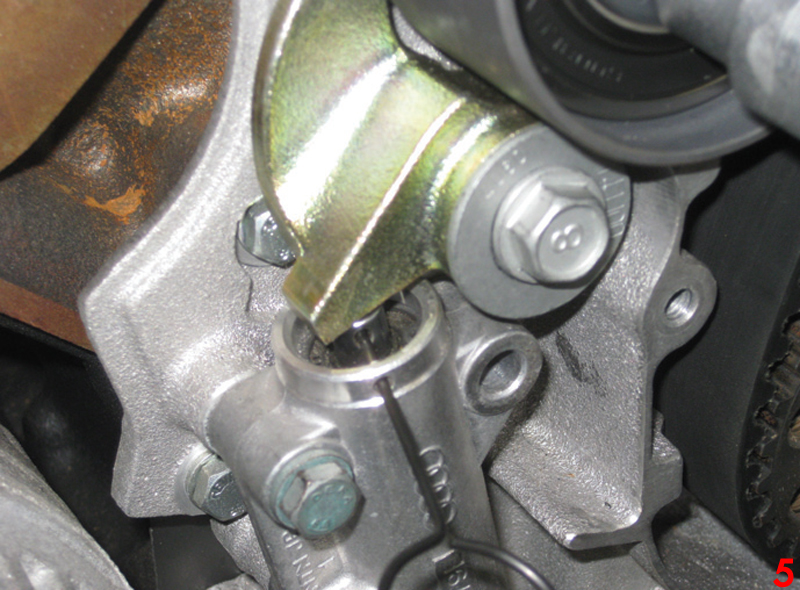
Always insert the hex key completely into the hex socket screw of the tension pulley (Fig 6) to ensure that the power is transmitted over a large area when turning the tension pulley against the piston of the damper. If this is not the case, then the tension pulley eccentric may break or tear. We recommend working with patience when pushing the piston rod into the damper casing by turning the tension pulley. The piston takes some time to push out the oil in the damper.
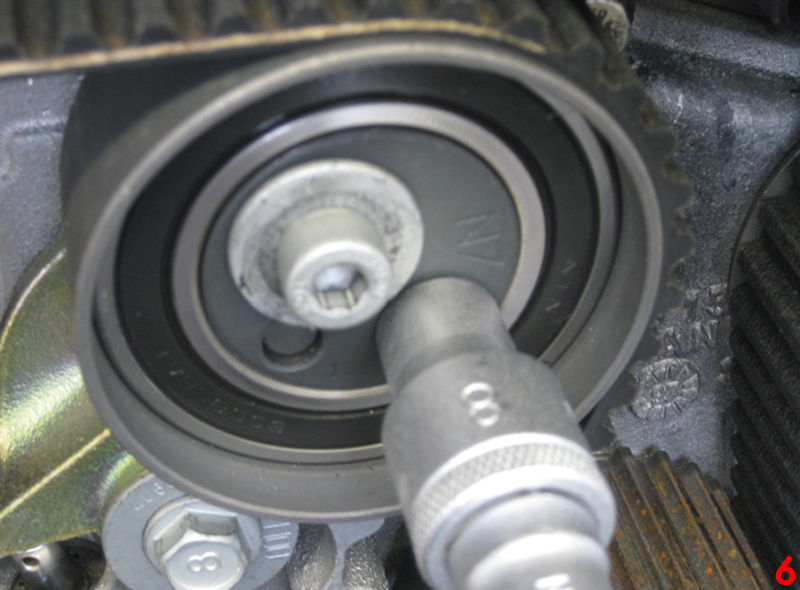
The next stage is to remove the following: the screws of the crankshaft belt pulley (not the crankshaft pulley), the crankshaft belt pulley, and the viscous fan mount. Note that for the Audis, the two screws on the mount can be reached through the hole in the belt pulley. Then, remove the lower timing belt cover, followed by the timing belt. Again, please note that when removing the tension pulley, remember to put the spacer back between the engine and the tension pulley (Fig 7).
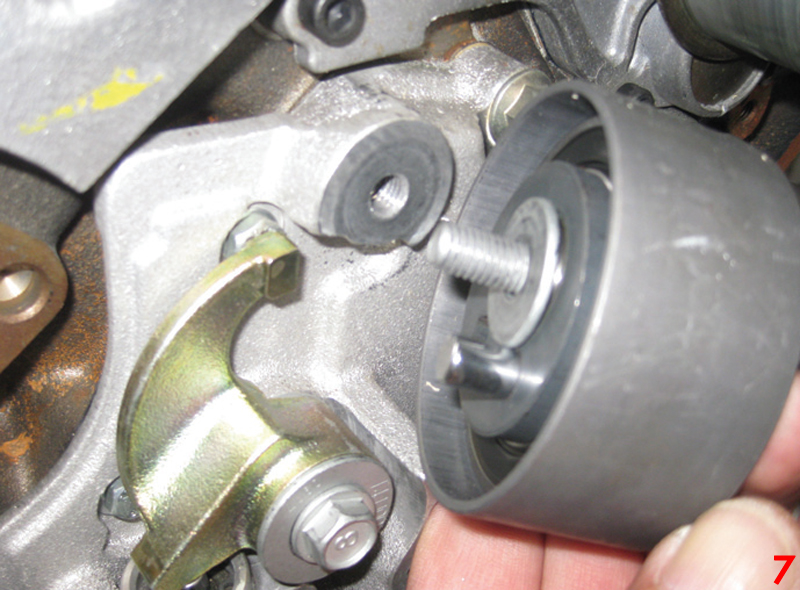
Installation
To install the new timing belt, follow the step-by-step guide below:
- Remove the camshaft sprockets
- Screw in an M10 screw into the camshaft as a counter bearing for the camshaft sprocket remover
- Loosen and remove both camshaft sprockets from their tapered end. Use the remover no. 3032
- Install the mounting plates and the screws
- Slightly tighten the screws for the camshaft sprockets. The camshaft sprockets must turn easily without tilting
- Place the timing belt around the camshaft sprockets and the water pump belt pulley
- Fit the locking tool (no. 3391) on the camshafts (Fig 8)
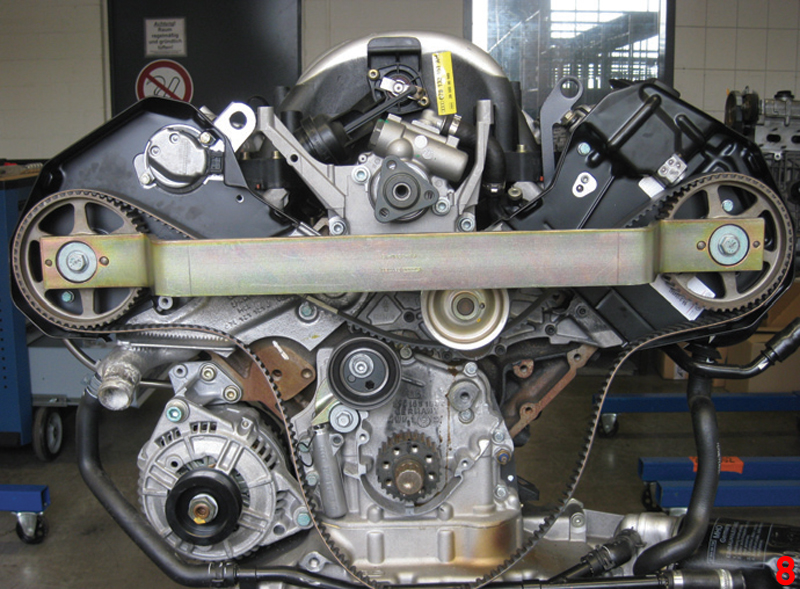
- The crankshaft locking tool must be fitted
- Place the timing belt around the guide roller, crankshaft sprocket and tension pulley (Fig 9)
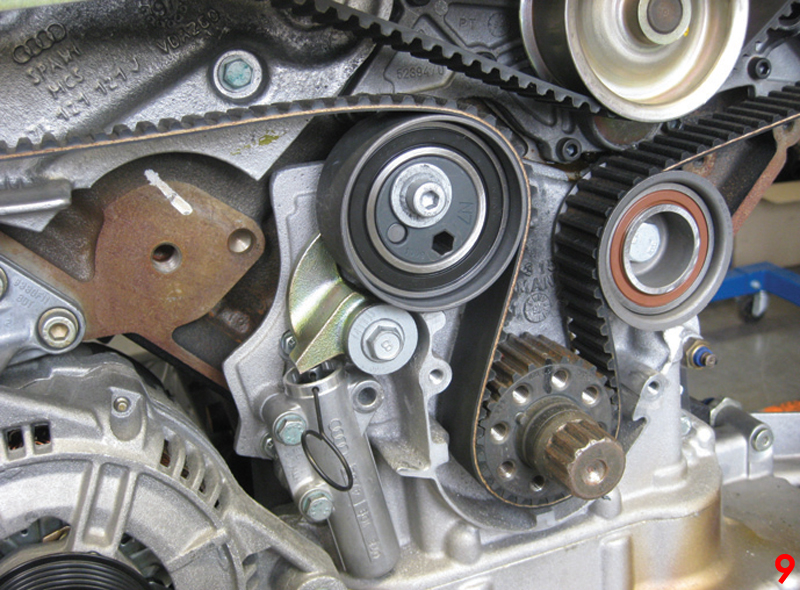
- Slightly turn the tension pulley to the right. Use the 8mm hex key for this. Remove the locking pin from the tensioner casing to release the clamping rod
- Apply the torque wrench to the hex socket screw of the tension pulley
- Tension the timing belt to 15Nm by turning to the left (Fig 10). Then, remove the torque wrench
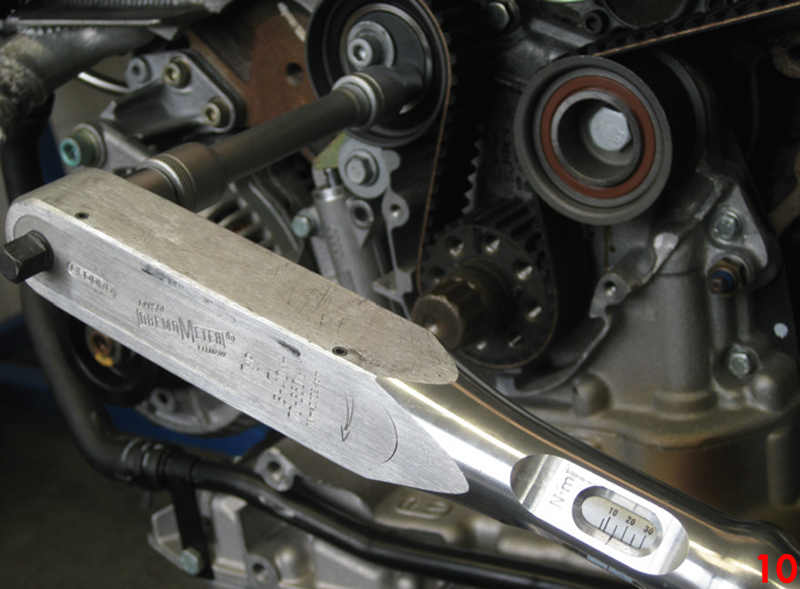
- Tighten the camshaft sprocket screw to 55Nm
- Remove the camshaft locking tool and the crankshaft locking tool
- Screw in the plug
- Fit the crankshaft belt pulley. The notches must be aligned to the nipple on the crankshaft sprocket (Audi)
- Tighten the screws on the crankshaft belt pulley for VW to 25Nm (Audi 20Nm)
- Install the components in reverse order of removal
For the final part of the process, record the replacement of the original Continental timing belt on the sticker provided and affix it in the engine compartment. Test run the engine or take a test drive.

